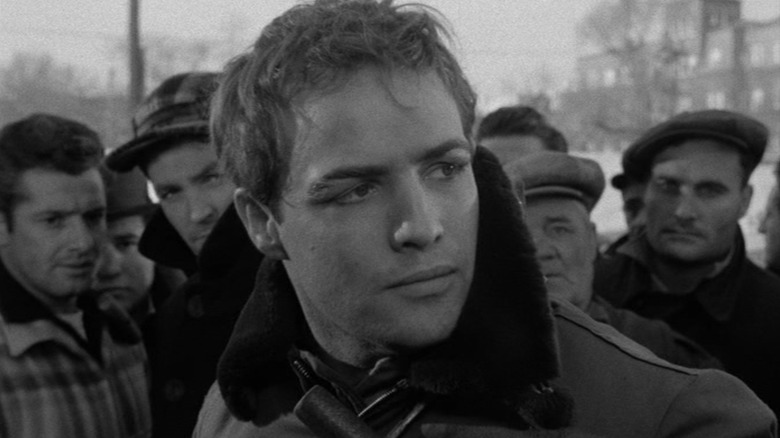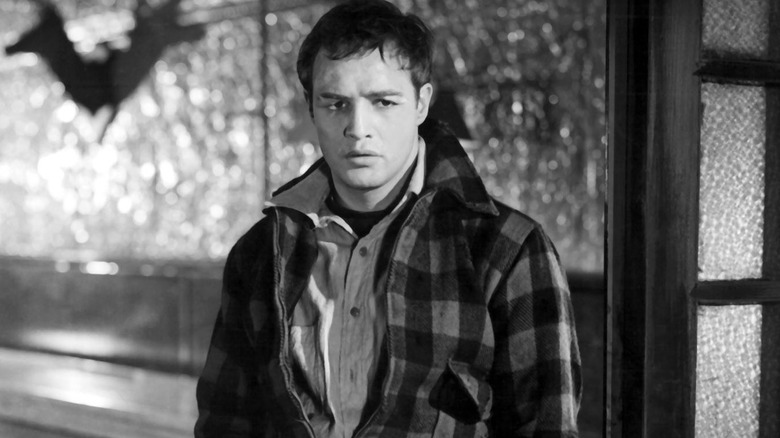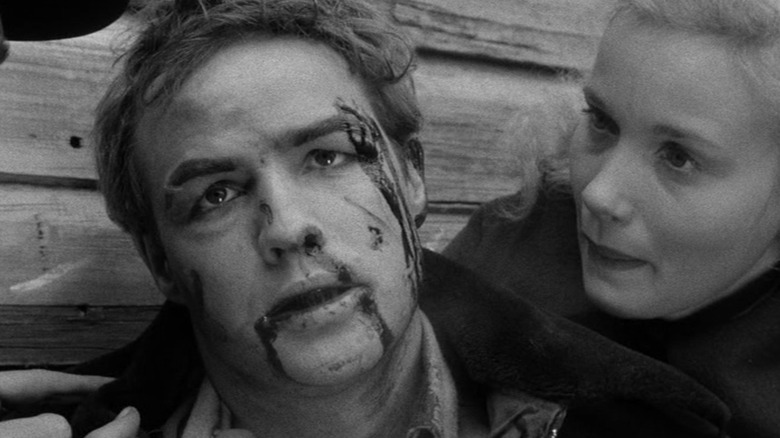Marlon Brando's On The Waterfront Role Marked A New Era For Movies
"On the Waterfront" is a classic film shrouded in controversy. The political turmoil surrounding the industry at the time, especially director Elia Kazan, forced the creative team to make several unconventional choices. Ultimately these circumstantial limitations and subsequent workarounds heralded a new style of dramatic filmmaking for major movie studios.
Kazan divided his colleagues in the film world and the American public alike when he chose to testify in the Joseph McCarthy hearings, naming several of his collaborators and friends as members of the Communist party. This alienated many major stars from working with Kazan again, including the leading man of "On the Waterfront," Marlon Brando. Brando was reportedly conflicted about signing onto "On the Waterfront" due to Kazan's testimony, according to the New Yorker.
The acclaimed 1954 drama stars Brando as Terry, a boxer who refuses to let himself be swayed by a local mobster. After the mob boss murders a man who was set to testify against him, Terry decides to take the stand himself. Kazan eventually admitted that the plot was a thinly veiled attempt at justifying his betrayal and encouraging viewers to sympathize with his sense of justice, per the New Yorker.
The gritty approach wasn't by choice
Despite the links between the director and the narrative to the unsavory actions of the House of Un-American Activities, Brando eventually agreed to participate, and "On the Waterfront" was a whopping success. Kazan's alienation from Hollywood forced him to seek unconventional settings for the film's production, and ultimately he took a neorealist approach. This applied not just to the stripped-down sets of Hoboken docks — a stark contrast to the manicured sets of L.A. studios — but also to Brando's acting style.
Moving away from the theatricality of Howard Hawks' noirs or Douglas Sirk's melodramas, Brando instead gave a decidedly toned-down performance as Terry. Brando's take on the role was heavily improvisational, the New Yorker reports, taking many creative liberties with the character's dialogue and direction. This bore a stark contrast to the heavily scripted films of big studio names like Alfred Hitchcock. Kazan was heavily complimentary of this performance, attributing it to the actor's ability to draw upon his own "inner conflict" to produce a powerful and evocative scene. This is characteristic of Brando's intense Method approach, which grounds acting in real-life experience and emotions. Brando, on the other hand, gives the cold New Jersey winter the credit for his performance, claiming that it was "so cold out there you couldn't overact."
Kazan killed the studio system
Whether the creative choices that ultimately led to the film's success were intentional or simply a result of circumstance, the film marked a transition in American filmmaking from the big-budget productions of the west coast to the rough-and-tumble style of the east. "On the Waterfront" marked the first step in Hollywood's transition from heavily manicured productions like "Gentlemen Prefer Blondes" in 1953 to gritty New Hollywood movies like the "Taxi Driver" (1976).
When a Supreme Court ruling in 1948 blocked major studios from selling blocks of films, it triggered the decline of the studio system over the next decade (via Constitution Daily). This process was accelerated by the McCarthy hearings, to which Kazan contributed directly. Kazan himself dealt the final blow to Hollywood's studio system while planting the first seed of its new, more artistic alternative.
The improvisational technique of Brando's acting combined with the on-location shooting is reminiscent of the Italian neorealism of the 1940s, which featured performances from non-actors and was shot in the streets of Italy's war-torn cities. A similar school of American filmmaking emerged decades later in response to the restrictive studio system. Groundbreaking films like "Bonnie and Clyde" (1967) would also take stylistic influence from Europe. "On the Waterfront" was a prototypical hint at a cinematic movement to come. The film contains the values and themes of Old Hollywood, but it has a bleakness that is uncharacteristic of its era.


